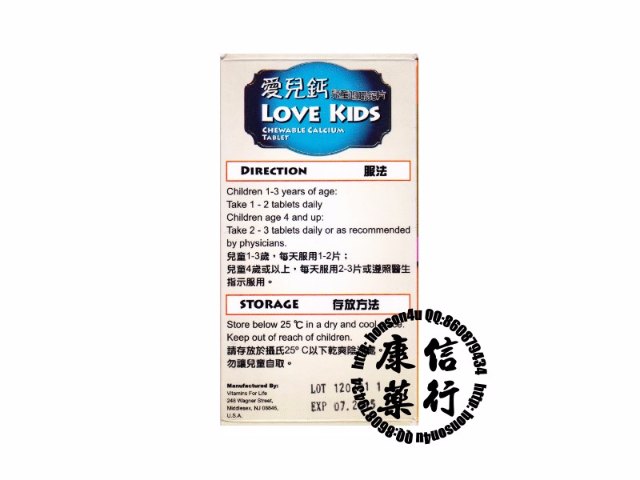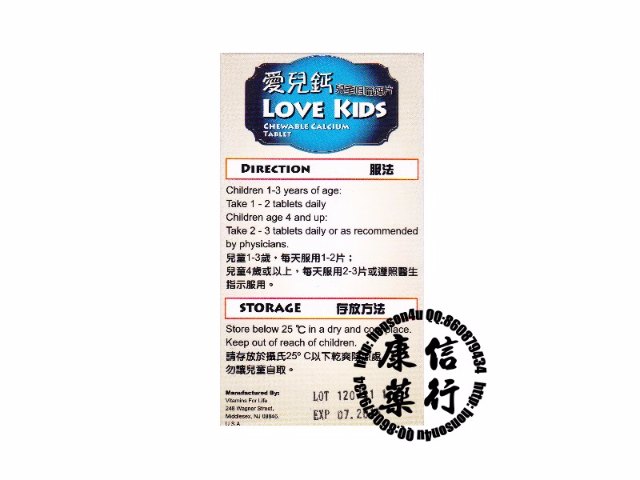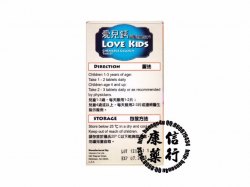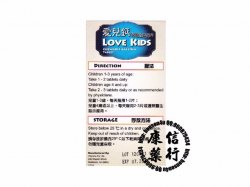


LOVE KIPS CHEWABLE CALCIUM TABLETS
Model: WZC0401
Product Description
LOVE KIPS CHEWABLE CALCIUM TABLETS
Calcium is a mineral which is extremely important for our bone health. Apart from building strong bones, calcium also plays important roles in regulating heartbeat, stimulating hormone secretions and conducting nerve impulses.
During childhood and adolescence calcium is in high demand for building strong bones and teeth. Puberty also increases the demand for calcium. Besides being a key for bone construction, calcium is required for nerve transmission, hormone release, and muscle contractions. Inadequate calcium intake would induce calcium to be pulled from bones to support cell functions which can result in weaker bones.
HOW MUCH CALCIUM DO YOUR KIDS NEED?
Milk is a prime source for calcium. Recommended calcium intake for children issued by the American Academy of Pediatrics is as follows:⑴
Age | Servings of milk per day | Calcium per day |
1-3 years old | 2 servings | 500mg |
4-8 years old | 2-3 servings | 800mg |
9-18 years old | 4 servings | 1300mg |
* 8 ounces of skim milk is equivalent to 300 mg of calcium
* 8 ounces of whole milk is equivalent to 276 mg of calcium
Children who will not or cannot drink milk, picky eaters and fast food culture may cause inadequate calcium. In addition, high levels of caffeine and phosphates in soda can further deplete calcium.
The most available source of calcium comes from dairy products: milk, yogurt and cheese. Other food sources include broccoli, oatmeal, and fortified orange juice. Calcium is also found in food such as dark green vegetable, nuts, grains, bean, canned salmon and sardines. However, it may be difficult to meet the daily calcium requirement unless we consume those foods daily. Therefore, calcium supplement is important to maintain sufficient calcium level for your body.
Calcium deficiency
Calcium deficiency can lead to severe problems such as poor blood clotting, osteoporosis, rickets and bone density issues. When the blood calcium levels fall down, the body starts borrowing calcium from bones and this weakens the bones. Therefore, it is very important to take foods high in calcium or calcium supplements to retrieve the calcium deficiency.
An Appetizing Supplement
Calcium carbonate is a common supplement people take when they do not receive enough calcium in their daily diet. It is a kind of mineral salt. Calcium carbonate is used as an antacid to relieve heartburn, acid indigestion, and stomach upset that reacts with excess stomach acid, producing water and carbon dioxide as products. Papaya fruit contains the digestive enzyme papain which is valuable for aiding digestion.
BENEFITS OF CHEWABLE CALCIUM TABLET:
♦ Crucial for development of good bones during childhood.
♦ Essential for building strong bones and teeth.
♦ Regulate muscle contraction and relaxation.
♦ Maintain proper nerve function.
♦ Suitable for children who do not obtain enough calcium from foods.
♦ Contain calcium carbonate, an easy way to receive calcium though diet.
♦ Fruit flavor and chewable, great tasting tablets.
RECOMMENDED DAILY POSE:
Children 1-3 years of age: Take 1-2 tablets daily. Children age 4 and up: Take 2-3 tablets daily or as recommended by physicians.
EFEREENCE
1. Greer FR, Krebs NF. American Academy of Pediatrics Committee on Nutrition. Optimizing Bone Health and Calcium Intakes of Infants, Children, and Adolescents. Pediatrics. 2006; 117(2):578-85.
2. Heaney RP. Calcium intake and disease prevention. Arq Bras Endocrinol Metabol. 2006;50(4):685-93.
3. Lorenzon NM, Beam KG. Disease causing mutations of calcium channels. Channels (Austin). 2008;2(3): 163-79.
4. Berchtold MW, Brinkmeier H, Miintener M. Calcium ion in skeletal muscle: its crucial role for muscle function, plasticity, and disease. Physiol Rev. 2000;80(3):1215-65.
5. Fraser CL, Samacki P. Inositol 1,4,5-trisphosphate may regulate rat brain Cai++ by inhibiting membrane bound Na(+)-Ca++ exchanger. J Clin Invest. 1990;86(6):2169-73.
6. Robinson M, Rodriguez-Stanley S, Miner PB, McGuire AJ, Fung K, Ciociola AA. Effects of antacid formulation on postprandial oesophageal acidity in patients with a history of episodic heartburn. Aliment Pharmacol Ther. 2002;16(3):435-43.
7. Mihaesco C, Seligmnan M. Papain digestion fragments of human IgM globulins. JExp Med. 1968; 127(3):431-53.
This product is not registered under the Pharmacy and Poisons Ordinance or the Chinese Medicine Ordinance. Any claim made for it has not been subject to evaluation for such registration. This product is not intended to diagnose, treat or prevent any disease.



